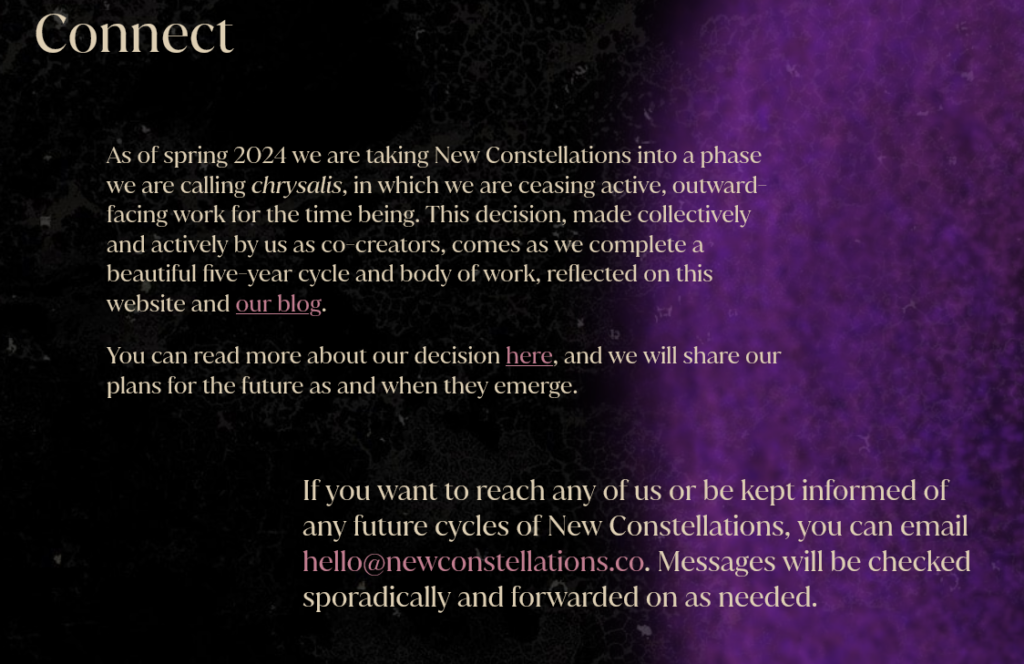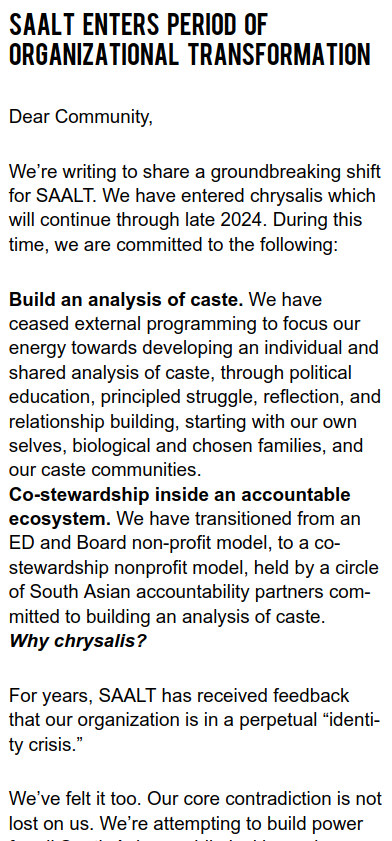In talking to people on the hotline, I meet them where they are in their closing journey. While some of them are certain they are closing, others are entering a period of deep discernment around the future of the group. When I hear a large amount of uncertainty, I will often suggest that they consider the possibility of pausing operations.
Pausing operations can give the organization time to:
- give the staff, board, volunteers, members time to address symptoms and causes of burnout;
- talk to funders about the situation;
- connect with partners about your challenges; and
- assess the impact of your organization’s (temporary) absence from the ecosystem.
Examples of Responsible Pauses
Over the years, I’ve collected a few examples of inspirational nonprofit pauses. Here are a few I really like.
Allied Media Conference’s Year of Chrysalis

In 2018, Allied Media Conference decided to take a year (2019) off to think about how they wanted to move forward after 20 years of operation. As part of the “chrysalis” period, they decided the conference would shift from annual to biannual. 2020 was the first virtual conference, with 2022 marking the final gathering.
In 2023, the parent organization Allied Media Projects announced that the conference would be sunsetting.
New Constellations’ Pause

New Constellations is a time-bound global initiative to support transformative community building. They announced their pause in 2024 after five years of operation.
SAALT’s Year of Chrysalis

South Asian Americans Leading Together (SAALT) announced a pause in late 2023. The group offers programs to support new immigrants, gather South Asian American leaders, and develop youth leadership. Their focus during this time of discernment is to try and tackle caste-ism in their ranks.
Elements of A Responsible Pause
While every pause is unique to the group and context, there are a few elements that make for a considered and successful pause period. Here are the aspects I have observed.
Structure the Pause
Determine Operations Level
Before you declare that you are in an organizational pause, you will need to define what pause will actually mean for your group. It can vary depending on the size of your organizations and the nature of you current commitments.
At Allied Media, their pause period did not mean bringing all operations to a stopping point. They operate as funders, facilitators, and fiscal sponsors, and that work needed to go on.
In another case, a community nonprofit noted that a possible pause could mean simply letting the existing programs, which were in partnership with a local school, run through the end of the school year and then not renew for the coming school year.
Your team will need to decide what can be stopped completely, keep running at a low hum, or remain functioning “as normal”.
Plan Some Activities
You will also need to develop arough outline of what you want to actually do during this time. Will you do a staff or board retreat? Will you have strategic board meetings?
You should consider connecting with a facilitator to explore how they might hold space for your group to have these necessary tough discussions. While the executive director or board president may be the person that normally facilitates gatherings, bringing in outside help gives them the permission to put their energy into group in a new and necessary way.
The pause is also a good time to consult with your funders and strategic partners. These people could have useful guidance for you, and in some cases, strategic partners might be able to help take over some of your programming or even be able to facilitate a merger or acquisition.
Set A Timeline
In addition to agreeing on how much to tune down operations and what you want to do during this time, you will also want to time-box your pause. It important to give yourself a reasonable deadline to make decisions. Aim to set a timeline that is sufficient to accomplish the tasks you laid out in the previous step with a little padding to accommodate the normal rhythms of life.
Communicate the Pause
Once you’ve determined the rough outlines of your pause, you need to let everyone know what is going on. In many communities, word travels fast so it’s important to make sure that internal people know fairly early on and don’t feel blindsided. You also need to communicate this shift to your fundraisers, your partners, and the greater public. Make sure to put a notice and explainer on your website and any social media your organization uses.
Note: You don’t have to use the word “chrysalis”!
Reporting Back
During and after your break, sharing what is going on/ went on can help foster transparency and trust within your community and the larger ecosystem. The challenges your organization is facing are likely not unique to you, and the lessons you learn can offer up a path forward to others who are facing similar situations. Update your blog and social media to let everyone know what’s up!
After Allied Media ended its chrysalis year, it shared its takeaways in several places, and it even cited conversations from the chrysalis year when they decided to transition their executive director two years later.
Take Action
Finally, after you’ve exited your own organization’s “cocoon”, it will be time to embark on actions to either spin back up operations to the new level, make staffing changes, articulate a new mission, or shift your focus to winding down operations. While you will have reported back via public channels, the same people who you communicated the pause to will also need to be informed of what the plan and direction will be moving forward.
When Pausing Is Not The Answer
While there is power in the pause, it is important to note that the pause is not a time of inaction, it is a time of active inventory and introspection. You will need to be available to meet, assess, brainstorm, and have deeply honest conversations about where you are now, how you got there, and possible paths forward.
If you don’t have a critical core of people on board to do this, it might be a sign that a considered closure is a better way forward. Saying “paused” when you mean “closed” can cause confusion and engender mistrust amongst your funders, partners, and the community you serve.
If there is only a little bit of gas left in the tank, I’ve found that it is better used to give the organization a respectful sunset. Using those final pushes to tie up loose ends, can ensure that you leave behind an honorable legacy and useful breadcrumbs for whoever picks up the work in the future.
(For more on this topic, check out the article “Permission To Pause” by The (now-defunct) Whitman Institute)

Leave a Reply